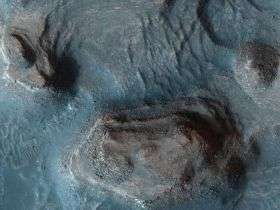Rocky Mesas of Nilosyrtis Mensae, Mars

Mesas in the Nilosyrtis Mensae region of Mars appear in enhanced color in this image from the High Resolution Imaging Science Experiment (HiRISE) camera on NASA's Mars Reconnaissance Orbiter (MRO).
The image, taken on April 5, 2007, is part of a campaign to examine more than two dozen candidate landing sites for the NASA Mars Science Laboratory rover, which is scheduled for launch in 2009.
This image shows a region of scientific interest to which the Mars Science Laboratory rover might drive. The rover would need to first land in a nearby area that is flatter and less rocky. Clay minerals have been detected in this region by imaging spectrometers on the European Space Agency's Mars Express orbiter and on MRO.
These minerals are of great interest in the search for evidence of life on ancient Mars. Someday the capability may exist for precision landing and hazard avoidance, so a rover could be set down right next to such rugged outcrops of interest for study and perhaps for collection of rock samples for return to Earth.
Source: NASA





















